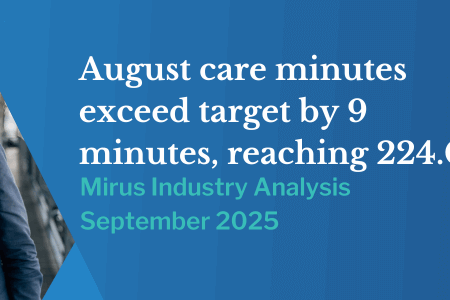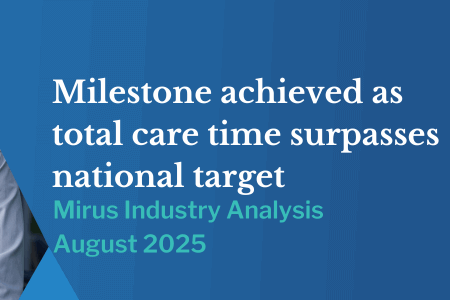Whiddon’s data-driven approach to getting care minutes right
August 26, 2025 | Provider Perspectives

By Dotti Gill, Marketing Manager
As one of Australia’s larger aged care providers, Whiddon operates 22 facilities with more than 1,600 beds across regional and metropolitan NSW. In our recent webinar, Getting Care Minutes Right, John Ashby, General Manager of Business Sustainability, shared how Whiddon has navigated the complex transition from ACFI to AN-ACC. Their approach has been one of precision, scale, and stability—ensuring compliance with care minute requirements while keeping wage overspend to a minimum. This article highlights how Whiddon has leveraged data, centralised rostering, and system discipline to deliver care minutes with consistency.
Precision, collaboration, and data-driven rostering
John highlighted Whiddon’s goal of achieving care minute targets within a tight margin, aiming to avoid exceeding targets by more than 0.5% to prevent costly overspend. “We’re doing a really good job in a complex and fast-changing environment,” he noted, highlighting that Whiddon was only 1.1% over target last quarter, equating to 440 hours across their facilities.
This precision is driven by a centralised rostering team that reviews care minute reports and supports facilities in aligning rosters with targets. A key strategy has been the development of robust systems and processes. Weekly care minute reports are shared with facility managers, followed by fortnightly meetings with facility and general managers to review performance and guide roster adjustments.
“We’ve had to adopt many systems and processes,” John explained, noting the importance of data visibility. Accurate, reliable data allows Whiddon to monitor performance and make informed decisions to stay aligned with targets.
The transition to AN-ACC brought significant challenges, including adapting to a new funding model and educating facility managers. “There was a lot of training, a lot of education,” John said. Initially focused on meeting targets, Whiddon has now shifted to prioritising efficiency, ensuring rosters align with care needs without excessive overspend.
Overcoming challenges: Flexible rostering and stakeholder collaboration
To manage fluctuating resident acuity and occupancy, Whiddon designs master rosters with flexibility—covering 80% of shifts with assigned staff and leaving 20% unallocated. “If you’ve got a fully staffed master roster, you’ve got nowhere to move,” John noted. This approach allows Whiddon to flex rosters up or down, adding shifts for increased care needs or pulling unassigned shifts when occupancy drops.
Collaboration across departments is also critical. Initially, Whiddon’s rostering process excluded admissions teams, leading to misaligned rosters when occupancy forecasts were off. Now, admissions, recruitment, finance, and building services teams are included in fortnightly meetings to align occupancy, refurbishment schedules, and staffing needs.
“Occupancy plays a significant role in managing care minutes,” John said, emphasising the need to factor in planned and unplanned leave and offline beds due to refurbishments.
Communication with frontline staff is equally vital. When adjusting rosters to align with targets, Whiddon ensures transparency to maintain staff engagement. “If you don’t share that information with frontline staff, they can become disengaged,” John stated. For example, when occupancy drops, Whiddon may offer additional leave to staff, explaining the rationale to keep them informed and aligned with organisational goals.
Looking ahead: Consistency and stability
John outlined Whiddon’s future priorities, focusing on roster stability and funding alignment. By collaborating with their AN-ACC team and using tools like Mirus Metrics, Whiddon aims to maintain consistent care minute targets quarter-to-quarter.
“Early days, we were having significant variations in care minute targets, which was destabilising,” John said. Now, the focus is on aligning master rosters with resident care needs and forecasted occupancy to avoid large fluctuations.
Whiddon is also enhancing staff engagement by involving recruitment teams to ensure adequate staffing for future quarters. “We want to maximise our revenue but remain consistent,” John noted, emphasising the importance of stable rosters for both residents and staff.
By refining data-driven processes and fostering cross-departmental collaboration, Whiddon aims to sustain compliance while minimising unfunded care and overspend.
Key Takeaways for Aged Care Providers
- Centralised rostering for precision: A dedicated rostering team, supported by weekly reports and fortnightly reviews, ensures alignment with care minute targets.
- Flexible roster design: Building master rosters with 20% unallocated shifts allows for quick adjustments to occupancy or acuity changes.
- Cross-departmental collaboration: Involving admissions, recruitment, finance, and building services ensures accurate forecasting and roster alignment.
- Transparent communication: Engaging frontline staff with clear rationales for roster changes maintains morale and alignment.
- Data-driven stability: Using tools like Mirus Metrics to align AN-ACC funding with care needs minimises variations and supports consistent care delivery.
Whiddon’s strategies demonstrate how large providers can achieve care minute compliance at scale by investing in precision, reliable systems, and cross-departmental collaboration. With a focus on stability and alignment, they show that consistency in rostering and funding performance is achievable, even in a fast-changing environment.
You can watch the full webinar recording here.
How we can help:
For providers looking to strengthen care minute compliance, Mirus offers tools and resources to support data-driven decisions. Mirus Metrics provides insights into AN-ACC performance and care minute allocations, while Care Minute Manager integrates with rostering systems to give daily visibility over care minute progress. These tools can help providers monitor compliance, identify potential underfunded care, and plan staffing more effectively.
To learn more about how Mirus supports care minute management, request a call back.


